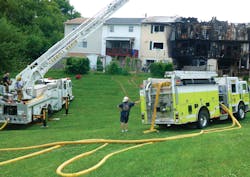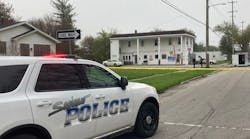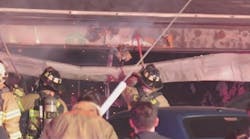This month, we will be discussing some strategic considerations for companies when they arrive at a working fire in a townhouse. Previously, we had discussed some of the more common issues with garden apartments, and townhouses have some similar considerations. We will take a look at how these issues affect the operations while at these types of residential units.
As previously stated, engine companies play a key part of the fireground operation and each of these units has specific responsibilities on-scene. Once again we will take each into consideration when dealing with townhouses.
A primary concern of the engine company is not only location of the fire, but also the access route for companies to efficiently reach the seat of the fire (see Photos 1 and 1A). It is important that the engine company members understand and recognize how fire spread may occur, particularly how fire may spread in these occupancies.
Issues For The Initial Company
One of the most critical issues with townhouses is that the living quarters are joined to each other on two sides. Usually, townhouses consist of multiple floors. This also means that the fire load and the victim potential on the upper floors is in the direct path of natural spread, allowing the fire to spread quickly and affect victim egress immediately (see Photo 2). Taking this into consideration, it is vital that control of the stairways and vertical/horizontal arteries in the occupancy are controlled by the first-arriving units. Getting handlines placed to protect the open stairway is a vital task to protect the occupants during their escape, and control most vertical fire spread. Many times, stairwells are open, as found in residential dwellings, and this allows for smoke and heated gases to spread to upper floors, and cuts off any escape paths that the victims may have.
Initial companies should also anticipate fire spread via pipe chases, void spaces and party walls, located throughout the structure. A party wall is a load-bearing wall that serves as a dividing partition between living units. This wall contains pocketing for floor joists from both residences. These open spaces will allow smoke and heat to travel horizontally, resulting in fire spread and possible smoke explosions in adjoining occupancies. It is imperative for companies to access these exposure units to check for extension.
Construction techniques result in voids for utilities and pipes throughout the dwelling, and can serve as an artery for flame spread. One of the biggest voids in the building will be located behind the bathroom wall, in the vicinity of the toilet. Construction practices will allow utilities for multiple occupancies to run in the same void space, increasing the size of the void and the amount of units exposed by the void. This area can be used for both the drain pipes and the vent pipes for each unit, each going in opposite directions. Open this void space and check it thoroughly whenever this area is potentially exposed to fire spread. Additionally, fire spread can travel in the soffit above the kitchen cabinets, allowing for vertical and horizontal spread (see Photo 3). A word of caution: many times kitchen floors have been the initial floors to collapse from below grade fires. In the event flame spread is discovered in the soffit, be sure to take early collapse into consideration.
Just like any other fireground, choosing the right line can make or break any operation. The initial arriving engine company officer has some critical thinking to do: choosing the right size line (diameter and length), and making sure the line can make the required flow to extinguish the fire. But first, the officer needs to know where the fire is, and what stage the fire is in; therefore, location and extent of the fire is considered the most important size-up concern for most officers. Furthermore, how will the company reach the entrance to the unit? Is the unit at the street or set back (see Photo 4)? Before the first company commits, locate the most efficient route to the fire, and then stretch in with the right attack line for fire flow and BTU consumption!
Fire conditions can dictate the use of either 1 3/4-inch or 2 1/2-inch handlines for needed fire flow, and when in doubt, it is best to go bigger. However, larger lines are usually reserved for commercial fires. But fire load in the larger homes of today can require the BTU consumption of a larger handline as well. Reaching the fire area is just as important, so bringing the right amount of hose is critical. There are two schools of thought on this:
- One length to the door, and one per floor. Add one working length to cover the floor area.
- Length plus width of the fire floor, plus one to the door. Don’t forget to add one working length into the equation.
Considering the size hose, the gallons per minute of flow, and the location the line needs to get to, be sure that the company is adequately staffed to get the hand line safely and efficiently into position.
The First-Arriving Engine Company
As the first engine is arriving, it is a good practice to stop prior to the fire building, and position at the corner of the structure for two reasons: it allows the company officer to step off the apparatus and see where the fire is in the building, so the best entrance into the complex can be utilized. Secondly, the company officer must take into consideration the potential for flashover, backdraft, utility hazards, auxiliary appliances, and potential of collapse, prior to committing personnel to the operation. As we discussed earlier, one of the most important size-up considerations is the location and extent of the fire. Considering the common use of engineered structural components in many types of multiple dwellings, this will set the mode of operation (offensive, defensive, Transitional, etc…) and units can then be assigned accordingly (see Photo 5). Don’t forget to pre-plan any auxiliary appliances for these occupancies. Support the sprinkler systems early into the alarm for the best potential for success (see Photo 6).
Initial fireground operations involve both suppression and ventilation. These crews must coordinate suppression with the arriving truck company ventilation team!!! If not, this can lead to huge problems on scene, and lack of coordination can lead to extreme fire behavior within the compartment. The officer must also report conditions inside the dwelling to the incident commander so tactics can be adjusted as needed.
The Second-Arriving Engine Company
The next-arriving company should position itself in order to secure a backup water supply. While this is getting done, the crew can enter the dwelling with a backup line: I prefer to go one size up and one length longer, but same diameter line at a minimum. This line has to be positioned to back up the first line in the event they run into problems, and to protect the stairs and means of egress for the crew and the residents. This crew should also protect the search team as they are operating, and coordinate ventilation with the truck company assigned this task. It may be possible that this line might be sent one floor up, to protect the search team and check for extension, but backing up the first team is still the number 1 priority!
It would be better suited to send a third team in with a third hoseline, to protect the floor above and check for extension. This would be a perfect job for the third-arriving engine company. Be sure to send this handline into the structure from a different location, as trying to work with three lines going through the same opening will become problematic. If a rescue is to be made, the amount of hose and manpower clogging up the opening may cause delays in victim/firefighter removal. Keep the egress points as clear as possible; identify access halls and stairways that can be used for rescue and suppression operations to ease congestion within the building.
Conclusion
The scene of a fire in a townhouse is a very taxing operation. Hazards such as open stairways to the upper floors are present, along with the hazards of engineered structural materials within the building. Both the engine and truck companies have critical tasks that must be done in a safe and efficient manner immediately upon arrival, and coordination of these activities is paramount for a successful outcome.
Until next time, stay focused and stay safe.






